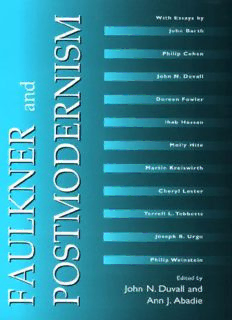
Faulkner and Postmodernism (Faulkner and Yoknapatawpha Series) PDF
Preview Faulkner and Postmodernism (Faulkner and Yoknapatawpha Series)
Faulkner and Postmodernism faulkner and yoknapatawpha 1999 ..........................9299$$ $$FM 05-10-0210:25:50 PS This page intentionally left blank Faulkner and Postmodernism faulkner and yoknapatawpha, 1999 edited by john n. duvall and ann j. abadie UNIVERSITYPRESSOFMISSISSIPPI JACKSON ..........................9299$$ $$FM 05-10-0210:25:50 PS www.upress.state.ms.us Copyright(cid:1)2002byUniversityPressofMississippi Allrightsreserved ManufacturedintheUnitedStatesofAmerica 10 09 08 07 06 05 04 03 02 4 3 2 1 (cid:2)(cid:1) LibraryofCongressCataloging-in-PublicationData FaulknerandYoknapatawphaConference(26th:1999:UniversityofMississippi) Faulknerandpostmodernism:FaulknerandYoknapatawpha,1999/editedby JohnN.DuvallandAnnJ.Abadie. p. cm. Elevenessaysfromthe1999FaulknerandYoknapatawphaConference,heldatthe UniversityofMississippi. ISBN1-57806-459-7(cloth:alk.paper)—ISBN1-57806-460-0(pbk.:alk.paper) 1.Faulkner,William,1897–1962—Criticismandinterpretation—Congresses. 2.Postmodernism(Literature)—UnitedStates—Congresses. 3.Postmodernism (Literature)—Mississippi—Congresses. 4.YoknapatawphaCounty(Imaginary place)—Congresses. 5.Mississippi—Inliterature—Congresses.I.Duvall,JohnN. (JohnNoel),1956– II.Abadie,AnnJ. III.Title. PS3511.A86Z7832113 1999 813(cid:2).52—dc21 2002000638 BritishLibraryCataloging-in-PublicationDataavailable ..........................9299$$ $$FM 05-10-0210:25:50 PS Contents Introduction vii johnn.duvall ANoteontheConference xvii ThePrivationsofPostmodernism:FaulknerasExemplar (AMeditationinTenParts) 1 ihabhassan PostmodernIntimations:MusingonInvisibility:William Faulkner,RichardWright,andRalphEllison 19 philipweinstein PostmodernYoknapatawpha:WilliamFaulknerasUsablePast 39 johnn.duvall ModernistDesign,PostmodernistParanoia:ReadingAbsalom, Absalom!withGravity’sRainbow 57 mollyhite ‘‘I’mthemanhere’’:GoDown,MosesandMasculineIdentity 81 terrelll.tebbetts RevisingTheSoundandtheFury:Absalom,Absalom!and Faulkner’sPostmodernTurn 95 doreenfowler Intertextuality,Transference,andPostmodernisminAbsalom, Absalom!:TheProductionandReceptionofFaulkner’s FictionalWorld 109 martinkreiswirth Postvomiting:PylonandtheFaulknerianSpew 124 josephr.urgo v ..........................9299$$ CNTS 05-10-0210:25:56 PS vi contents MakeRoomforElvis 143 cheryllester FaulknerbytheLightofaPaleFire:PostmodernTextual ScholarshipandFaulknerStudiesattheEndoftheTwentieth Century 167 philipcohen MyFaulkner 192 johnbarth Contributors 196 Index 199 ..........................9299$$ CNTS 05-10-0210:25:57 PS Introduction 1 Relating William Faulkner to postmodernism is a task complicated by the plethora of ways that postmodernism has been defined and period- ized.Thereeffectivelyareinplaythreedistinctversionsofpostmodern- ism—the philosophical, the cultural, and the aesthetic. And while the time frame of the latter two can be reconciled to some extent, it does notsquarewiththatofphilosophicalpostmodernism.Ju¨rgenHabermas’s philosophical modernity, for example, begins with Descartes’s belief in the self-sufficiency of reason and continues through Kant and the En- lightenment; Habermas’s postmodernism beginswith Nietzsche’s attack onreason.Thereis,therefore,atleastathree-hundred-yeargapbetween Habermas’smodernityandaestheticmodernism,asituationrenderedall themorecomplexinasmuchascertainversionsofmodernistaesthetics— surrealism,Dadaism,mythicintuitionism—wouldfallnecessarilywithin Habermas’spostmodernism.(ThatJeanFran¸coisLyotardlocatesthebe- ginning of modernity with Nietzsche shows additionally how easily the termsofthephilosophicaldebatecancreateconfusion.) WhenImovedtoPurdueUniversityin1998,Idiscoveredadifferent issue of definition and periodization—an overlap in the division of the graduate American literature curriculum in the break between what we callAmericaIIandAmericaIII.AmericaIIisdefinedastheperiodfrom theCivilWar to1940.AmericaIII,though,runsfrom1930tothe pres- ent.Asacolleague explaineditto me,this oddconfigurationreflecteda compromiseina disputebetweenthemodernist andpostmodernschol- ars over who would get William Faulkner.1 Despite Faulkner’s usual identification as a high modernist, our period compromise at Purdue is notcompletelyidiosyncratic,asIhopetomakeclearinthisintroduction. Theveryterm‘‘postmodernism,’’however,stillseemstomanyunder- graduatesanoddterm,onethatstrainscommonsense.Afterall,welive in the modern world, don’t we, so how can anything be designated as after the modern? But of course the ‘‘modern’’ in modernism does not refer to the popular sense but to an aesthetic and a period of literary history. (That ‘‘modernism’’ is contained in the word ‘‘postmodernism’’ shouldsignalthatthetwotermsarenotunrelated.)Ifmodernismcanbe defined as the art’s response to the alienating effects of modernization vii ..........................9299$$ INTR 05-10-0210:26:05 PS viii introduction and mass culture, then two questions emerge: is there a point at which alienation ceases to be the dominant affect or emotional felt response thatpeoplehavetotheircontemporaryexistence,and,ifyes,istherean aestheticthataddressesthisnewaffect? Thetimemarkingtheperiodbreakbetweenmodernismandpostmod- ernism noticeably varies depending on which literary historian one be- lieves. Some have seen the end of World War II and the advent of the nuclearageasthedividingline.Otherspointtothecanonizationofhigh modernisminthelate1950sandearly’60sasthekeyperiodbreak.Here thethinkingisthatoncethemodernistscanbefoundbetweenthecovers of the various standard literary anthologies, whatever radical agendas (whetherformalorpolitical)thatthemodernistsmayhavehadhavebeen co-optedbythe orderofthings.Stillotherswhowishtolinkcontempo- raryarttothegrowthofmultinationalcapitalismhavefixedpostmodern- ism’s beginning as 1973 and the Arab oil embargo. Whichever date one prefers,itmaybepossibletochartaprogressivecomplicationofthefelt alienation of the early part of the twentieth century. Following World WarII,thecontinuousthreatofnuclearannihilationcausesalienationto transform into the paranoia of the Cold War. More recently still, the whirlingblitzofinformationandimagesintheageofcomputersandthe electronic media has made it much more difficult to sort the significant informationfromthewhitenoiseofculture,somuchsothatperhapsthe paranoia of the second half of the twentieth century has segued into a kindofmillennialschizophrenia. If paranoia and schizophrenia are metaphors describing what it feels liketoliveinthecontemporaryworld,thepostmodernwriterthematizes such matters around the representation of identity and identity forma- tion. The modernist still held out hope for authentic identity. Paris may havebeenawastelandforthewoundedJakeBarnesinErnestHeming- way’s The Sun Also Rises, but at least Pamplona, Spain, represented a site of authentic masculinity. The postmodernists, however, tracking in the paths of the poststructuralist critique of unified subjectivity, repre- sentidentityasanideologicalmirage,muchmoreasocialconstructora performancethananauthenticity. Havingsaidthisaboutthepostmoderndifference,Icouldimmediately turntoQuentinCompson’ssenseofidentityinTheSoundandtheFury toraiseanobjectiontothedistinction.Sittingnextto anAfricanAmeri- can man on a streetcar, Quentin reflects on how living in the North has reshaped his sense of race and realizes ‘‘that a nigger is not a person so much as a form of behavior; a sort of obverse reflection of the white people he lives among.’’2 Quentin’s momentary reflection—in which blackness and ‘‘nigger’’ become unhinged—envisions identity not as an ..........................9299$$ INTR 05-10-0210:26:05 PS introduction ix essence or an authenticity but as the performance of social scripts. Yet despiteinstancesinFaulkner’sfictioninwhichhischaractersseemingly embraceas an intellectual propositionthismore contemporaryperspec- tive on identity, they generally do not experience themselves and their ownsubjectivitiesassoradicallycontingentanddecentered. One should anticipate, therefore, the response of certain readers for whom any linking of William Faulkner to postmodernism (much less an entireconference on the subject)will strikethem as perverse. ‘‘Surely,’’ they might object, ‘‘Faulkner is unmistakably a high modernist whose writing ought to be spoken of in relation to James Joyce’s, not Thomas Pynchon’s.’’ But even if one grants this objection, then Faulkner’s texts should allow us a point of reference from which to begin to define the postmodern difference and perhaps allow us, if not exactly to mark the momentwhenpostmodernismbegins,atleasttosaywhatapostmodern textdoes. Thinking about these matters had begun well before I proposed this conference on ‘‘Faulkner and Postmodernism.’’ In 1987, Brian McHale turnedtoAbsalom,Absalom!asaliminaltext,onestandingontheborder between modernism and postmodernism. For McHale, a particular mo- mentinchapter8ofAbsalomsuggeststhat‘‘modernistpoeticsthreatens to break down, or more than threatens, actually does break down’’; this rupture ‘‘dramatizes the shift of dominant from problems of knowing to problems of modes of being—from and epistemological dominant to an ontological one.’’3 In other words, the novel in one vertiginous moment moves us away from modernism’s obsessive questioning (‘‘How do we reallyknowThomasSutpenorAddieBundrenor,forthatmatter,Orson Welles’s Charles Foster Kane?’’) and toward an eerie uncertainty about exactlywhatkindofworlditisthatisbeingimagined: InCh.8,QuentinandShrevereachthelimitoftheirknowledgeoftheSutpen murder-mystery; nevertheless they go on, beyond reconstruction into pure speculation.Thesignsofthe narrativeactfallaway,andwiththemallques- tionsofauthorityandreliability.Thetextpassesfrommimesisofthevarious characters’narrationstounmediateddiegesis,fromcharacters‘‘telling’’tothe author directly ‘‘showing’’ us what happened between Sutpen, Henry, and Bon. The murder-mystery is ‘‘solved,’’however, not through epistemological processes of weighting evidence and making deductions, but through the imaginative projection of what could—and,the text insists, must—have hap- pened.4 Turning to Linda Hutcheon’s Poetics of Postmodernism, one may again wonderaboutFaulknerandpostmodernism.ForHutcheon,postmodern fictionisdefinedas‘‘historiographicmetafiction.’’Bythisshemeansfic- ..........................9299$$ INTR 05-10-0210:26:05 PS
Description: